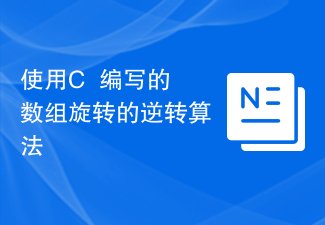
In this article, we need to reverse the link with the help of a singly linked list. Our task is to create a function that can reverse a given singly linked list. For example
Input: Following Linked list : 1->2->3->4->NULL Output: After processing of our function: 4->3->2->1->NULL
Methods to find solution
There are different ways to reverse a linked list. Usually, we think of a simple way of reversing the linked list while traversing it.
Simple Method
In this method, we will traverse the linked list and try to reverse it during the traversal.
Example
#include<bits/stdc++.h>
using namespace std;
struct Node {
int data;
struct Node* next;
Node(int data) {
this->data = data;
next = NULL;
}
};
struct LinkedList {
Node* head;
LinkedList() { head = NULL; }
// Function to print linked list
void reverse() {
auto curr = head; // current pointer
Node* prev = NULL; // previous pointer
while(curr) {
auto temp = curr -> next;
curr -> next = prev;
prev = curr;
head = prev;
curr = temp;
}
}
void print() {
struct Node* temp = head;
while (temp != NULL) {
cout << temp->data << " ";
temp = temp->next;
}
}
void push(int data) {
Node* temp = new Node(data);
temp->next = head;
head = temp;
}
};
int main() {
LinkedList list;
list.push(20);
list.push(4);
list.push(15);
list.push(85);
list.print();
list.reverse();
cout << "\n";
list.print();
}Output
85 15 4 20 20 4 15 85
In this approach, we just iterate through the list and reverse it during the iteration. This is a good approach because the time complexity is O(N), where N is the size of our list.
Now we try to do an experiment and try to reverse the list using the stack.
Methods using stack
We will use a stack to store all the nodes in this program and reverse them by traversing the stack.
Example
#include<bits/stdc++.h>
using namespace std;
struct Node {
int data;
struct Node* next;
Node(int data) {
this->data = data;
next = NULL;
}
};
struct LinkedList {
Node* head;
LinkedList() { head = NULL; }
// Function to print linked list
void reverse() {
auto curr = head; // current pointer
Node* prev = NULL; // previous pointer
stack<Node *> s;
while(curr) {
s.push(curr);
curr = curr -> next;
}
prev = s.top();
head = prev;
s.pop();
while(!s.empty()) {
auto temp = s.top();
s.pop();
prev -> next = temp;
prev = temp;
}
prev -> next = NULL;
}
void print() {
struct Node* temp = head;
while (temp != NULL) {
cout << temp->data << " ";
temp = temp->next;
}
}
void push(int data) {
Node* temp = new Node(data);
temp->next = head;
head = temp;
}
};
int main() {
LinkedList list;
list.push(20);
list.push(4);
list.push(15);
list.push(85);
list.print();
list.reverse();
cout << "\n";
list.print();
}
Output
85 15 4 20 20 4 15 85
Explanation of the above code
In this method we store the list nodes in the stack while traversing the list , then use the stack to pop them and reverse the list; the time complexity of this approach is also O(N), where N is our list size. As before, we used the stack, so we can also use the recursive method, because recursion also uses the stack, and now we will use the recursive method.
Recursive Method
In this method we will perform the same process as before but using recursive calls.
Example
#include<bits/stdc++.h>
using namespace std;
struct Node {
int data;
struct Node* next;
Node(int data) {
this->data = data;
next = NULL;
}
};
struct LinkedList {
Node* head;
LinkedList() { head = NULL; }
// Function to print linked list
void rreverse(Node *curr, Node *prev) {
if(curr == NULL) {
// prev -> next = curr;
head = prev;
return;
}
rreverse(curr -> next, curr);
curr -> next = prev;
prev -> next = NULL;
}
void reverse() {
auto curr = head; // current pointer
Node* prev = NULL; // previous pointer
rreverse(curr -> next, curr);
}
void print() {
struct Node* temp = head;
while (temp != NULL) {
cout << temp->data << " ";
temp = temp->next;
}
}
void push(int data) {
Node* temp = new Node(data);
temp->next = head;
head = temp;
}
};
int main() {
LinkedList list;
list.push(20);
list.push(4);
list.push(15);
list.push(85);
list.print();
list.reverse();
cout << "\n";
list.print();
}Output
85 15 4 20 20 4 15 85
In this method we are doing the same as before but using recursive calls so the time complexity of this method is also O(N), where N is the size of our list.
Conclusion
In this article, we solved the problem of inverting a singly linked list. We also learned the C program and the complete method (normal method and two other methods) to solve this problem. We can write the same program in other languages like C, Java, Python and others. Hope you find this article helpful.
The above is the detailed content of Reverse a linked list using C++. For more information, please follow other related articles on the PHP Chinese website!
 使用C++编写代码,找到第N个非平方数Aug 30, 2023 pm 10:41 PM
使用C++编写代码,找到第N个非平方数Aug 30, 2023 pm 10:41 PM我们都知道不是任何数字的平方的数字,如2、3、5、7、8等。非平方数有N个,不可能知道每个数字。因此,在本文中,我们将解释有关无平方数或非平方数的所有内容,以及在C++中查找第N个非平方数的方法。第N个非平方数如果一个数是整数的平方,则该数被称为完全平方数。完全平方数的一些例子是-1issquareof14issquareof29issquareof316issquareof425issquareof5如果一个数不是任何整数的平方,则该数被称为非平方数。例如,前15个非平方数是-2,3,5,6,
 使用C++编写的数组右旋转的反转算法Sep 08, 2023 pm 08:17 PM
使用C++编写的数组右旋转的反转算法Sep 08, 2023 pm 08:17 PM在本文中,我们将了解逆转算法,将给定的数组向右旋转k个元素,例如−Input:arr[]={4,6,2,6,43,7,3,7},k=4Output:{43,7,3,7,4,6,2,6}Explanation:Rotatingeachelementofarrayby4-elementtotherightgives{43,7,3,7,4,6,2,6}.Input:arr[]={8,5,8,2,1,4,9,3},k=3Output:{4,9,3,8,5,8,2,1}寻找解决方案的方
 在C编程中,找到一个圆的面积Aug 25, 2023 pm 10:57 PM
在C编程中,找到一个圆的面积Aug 25, 2023 pm 10:57 PM圆是封闭图形。圆上的所有点到圆内一点的距离都相等。中心点称为圆心。点到圆心的距离称为半径。面积是封闭图形尺寸跨度的定量表示。圆的面积是圆的尺寸内包围的面积。计算圆面积的公式,Area=π*r*r为了计算面积,我们给出了圆的半径作为输入,我们将使用公式来计算面积,算法STEP1:Takeradiusasinputfromtheuserusingstdinput.STEP2:Calculatetheareaofcircleusing, area=(
 使用C++找到数组中唯一配对的数量Sep 07, 2023 am 11:53 AM
使用C++找到数组中唯一配对的数量Sep 07, 2023 am 11:53 AM我们需要适当的知识才能在C++的数组语法中创建几个唯一的对。在查找唯一对的数量时,我们计算给定数组中的所有唯一对,即可以形成所有可能的对,其中每个对应该是唯一的。例如-Input:array[]={5,5,9}Output:4Explanation:Thenumberofalluniquepairsare(5,5),(5,9),(9,5)and(9,9).Input:array[]={5,4,3,2,2}Output:16寻找解决方案的方法有两种方法可以解决这个问题,它们是−
 使用C++编写代码,找到具有相同最小值和最大值的子数组的数量Aug 25, 2023 pm 11:33 PM
使用C++编写代码,找到具有相同最小值和最大值的子数组的数量Aug 25, 2023 pm 11:33 PM在本文中,我们将使用C++解决寻找最大值和最小值相同的子数组数量的问题。以下是该问题的示例−Input:array={2,3,6,6,2,4,4,4}Output:12Explanation:{2},{3},{6},{6},{2},{4},{4},{4},{6,6},{4,4},{4,4}and{4,4,4}arethesubarrayswhichcanbeformedwithmaximumandminimumelementsame.Input:array={3,3,1,5,
 使用C++按给定大小将双向链表分组反转Sep 04, 2023 am 09:49 AM
使用C++按给定大小将双向链表分组反转Sep 04, 2023 am 09:49 AM在这个问题中,我们得到一个指向链表头部的指针和一个整数k。在大小为k的组中,我们需要反转链表。例如-Input:1<->2<->3<->4<->5(doublylinkedlist),k=3Output:3<->2<->1<->5<->4寻找解决方案的方法在这个问题中,我们将制定一个递归算法来解决这个问题。在这种方法中,我们将使用递归并使用递归来解决问题。示例#include<iostream&
 使用C++编写的数组旋转的逆转算法Aug 28, 2023 pm 11:13 PM
使用C++编写的数组旋转的逆转算法Aug 28, 2023 pm 11:13 PM在给定的问题中,我们有一个数组,并且我们需要使用反转算法将数组旋转d个元素,例如−Input:arr[]=[1,2,3,4,5,6,7],d=2Output:arr[]=[3,4,5,6,7,1,2]Explanation:Asyoucanseewehavetorotatethisarraybyd=2butourmaintaskistoachievethisbyusingareversaltechnique.我们对数组的旋转进行了一些反转技术的计算,并得出结论:首先,我们反转
 使用C++编写,找到一个集合上的自反关系的数量Aug 26, 2023 pm 08:17 PM
使用C++编写,找到一个集合上的自反关系的数量Aug 26, 2023 pm 08:17 PM在本文中,我们将解释在一个集合上找到反身关系的方法。在这个问题中,我们给出一个数字n,以及一个由n个自然数组成的集合,我们必须确定反身关系的数量。反身关系-如果对于集合A中的每个'a',(a,a)属于关系R,则称关系R是集合A上的反身关系。例如-Input:x=1Output:1Explanation:set={1},reflexiverelationsonA*A:{{1}}Input:x=2Output:4Explanation:set={1,2},reflexiverelationsonA*


Hot AI Tools

Undresser.AI Undress
AI-powered app for creating realistic nude photos

AI Clothes Remover
Online AI tool for removing clothes from photos.

Undress AI Tool
Undress images for free

Clothoff.io
AI clothes remover

AI Hentai Generator
Generate AI Hentai for free.

Hot Article

Hot Tools

mPDF
mPDF is a PHP library that can generate PDF files from UTF-8 encoded HTML. The original author, Ian Back, wrote mPDF to output PDF files "on the fly" from his website and handle different languages. It is slower than original scripts like HTML2FPDF and produces larger files when using Unicode fonts, but supports CSS styles etc. and has a lot of enhancements. Supports almost all languages, including RTL (Arabic and Hebrew) and CJK (Chinese, Japanese and Korean). Supports nested block-level elements (such as P, DIV),

MantisBT
Mantis is an easy-to-deploy web-based defect tracking tool designed to aid in product defect tracking. It requires PHP, MySQL and a web server. Check out our demo and hosting services.

SAP NetWeaver Server Adapter for Eclipse
Integrate Eclipse with SAP NetWeaver application server.

Atom editor mac version download
The most popular open source editor

MinGW - Minimalist GNU for Windows
This project is in the process of being migrated to osdn.net/projects/mingw, you can continue to follow us there. MinGW: A native Windows port of the GNU Compiler Collection (GCC), freely distributable import libraries and header files for building native Windows applications; includes extensions to the MSVC runtime to support C99 functionality. All MinGW software can run on 64-bit Windows platforms.







